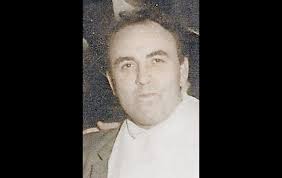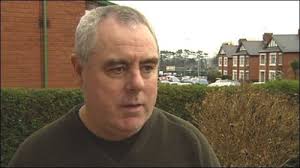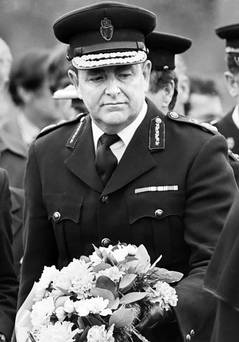I went to see The Ferryman at the Bernard Jacobs Theatre in Broadway recently with decidedly mixed expectations of Jez Butterworth’s play, which is set in Northern Ireland at the climax of the 1981 IRA hunger strikes.

The work was hailed as a masterpiece by critics when it premiered in London’s West End last May, and now the same has happened in New York where the critics have been, if anything, more extravagant in their praise.
But two reviews I’d read, which I posted on this blog last year, soured me. One, by The New York Times’ chief theatre critic, Ben Brantley (whose verdict can reputedly make or break a production) called The Ferryman:
‘…(a) fiercely, gripping play’ that ‘overflows with storytelling vitality, the kind that so holds the attention that three and a quarter hours seem to pass in the blink of an eye….’
But (in his review of the London production) he went on to say this about Butterworth’s work:
‘….The Ferryman portrays a people in thrall to milleniums of history, in ways they’re not always aware of’.
I groaned inwardly. Why are only the Irish in thrall to their history? Why never the Brits or the Americans? What is Brexit about if it is not inspired at least in part by (an imaginary) glorious imperial past when ‘wogs began at Calais’, Jacob Rees-Mogg lookalikes ruled millions of Indians and Africans, and half the globe was daubed a regal red?

Jacob Rees-Mogg
What is ‘Make America Great Again’ about, if not an appeal to a past in which America was ruled and guided by heterosexual Wasps? Why are these peoples not in thrall to their history but the greatest flaw of the Irish is that they always are?
If The Ferryman reflected this caricature of Ireland, especially the Ireland of 1981, then I had better ways to spend three-and-a-bit hours.
And then a riposte to Brantley appeared in The Guardian a couple of months later which seemed to confirm my doubts. It was written by Sean O’Hagan, one of the paper’s feature writers, who protested at the Irish stereotypes littering what is (a lot of the time) a very crowded stage:
‘….the relentless drinking, the references to fairies, the Irish dancing, the dodgy priest, the spinster aunts….’.
He concluded:
‘What I had witnessed, and in part enjoyed, was a play that revealed more about English attitudes to Ireland than it did about Northern Ireland’.
All of which persuaded me to give The Ferryman a miss, until a generous friend treated myself and Joan to tickets. And so off we went to Broadway & 56th Street, expecting, if not the worst, then not much better.
And boy, was I wrong. The Ferryman is not flawless, for sure, but buried in the drama, not too deeply, but clearly beyond the reach of the reviewers cited here, lies a truth about the conflict in Northern Ireland, and the nature of the IRA leadership propelled to power by the events described in this play. Together they mark out The Ferryman as a special creation, and Jez Butterworth as a talented, diligent and perceptive writer.

Jez Butterworth
If I was Gerry Adams, The Ferryman would chill my heart; the play foreshadows a place in history that could well become his touchstone. But more of that anon.
None of this is to say that the criticisms made by Sean O’Hagan are misplaced. The stereotypes are there in abundance, especially the drinking which not only has the children tippling, but vast quantities of Bushmills are consumed, perhaps the most expensive whiskey on the Irish market, well beyond the means of most farming families (I counted three bottles drunk in one day).
And the cursing by the children grates; girls of six, seven or eight in most Irish families do not say ‘Fuck’ in front of adults, repeatedly, or in the presence of relatives. And that is before you get to the mysticism, the faeries and dancing.
But I have to say my misgivings about all this diminished as the defining and powerful core of the play revealed itself.
Set in a Co Armagh farmhouse as the 1981 hunger strikes reach their exhausted conclusion – Micky Devine, the 10th and last hunger striker to die, succumbs as the play comes to a bloody conclusion – The Ferryman focuses on the Carney family, particularly Quinn Carney, the family’s dominant male and himself a former IRA internee, as they come to terms, each in their own way, with the news that the body of Seamus Carney – their brother, husband, father, uncle, nephew – has been found in a peat bog in Co. Louth. He has a bullet hole in his skull.
Seamus Carney disappeared in January 1972, New Year’s day to be exact, and while rumours swirled, and eyewitnesses lined up to testify that he had gone to Liverpool, or Wales and that he had even been seen in Loyalist Carrickfergus, the truth is that he was killed by the IRA, apparently because he was judged to be an informer, and his body hidden in the bog – and no-one, least of all his nearest and dearest told. He was one of the IRA’s ‘Disappeared’.
This part of the play echoes the real history of the ‘Disappeared’. I couldn’t help but think of Joe Lynskey as I watched the drama unfold. My mind went back to the day I met Joe’s family in 2009 to tell them what had really happened to him, as told by the late Brendan Hughes in his interviews with Boston College, and also later, in separate interviews, given by Dolours Price, who had ferried Joe to his death. There were disturbing echoes of Joe Lynskey’s death in The Ferryman.

Joe Lynskey
Lynskey was the very first person dispatched to a secret grave on the orders of the Belfast IRA leadership in mid 1972.
Like the Carney’s, his family was fed lies about various sightings, in one instance that he had been spotted as far away as Australia. But unlike Seamus Carney, Joe’s remains have never been recovered.
And deception of the sort peddled to the Lynskeys was cooked up for the other families. When you think about it, someone, somewhere in the IRA must have been given the task of overseeing the process, composing the lies, timing their release for maximum effect, recruiting and briefing delivery boys (surely the lowest form of life in this story), making sure every family was serviced – or at least those who otherwise might kick up dust – and ensuring that each lie was consistent with its predecessor and so on. A factory of lies no less. Hidden away in an attic or under floorboards somewhere in Ireland, there will be a cardboard box filled with a record of its product.
In The Ferryman, the IRA recruit a tame priest to tell the Carney family that their disappeared kinsman has been found; and then a trio of IRA heavies appear at the household just as the family is beginning an end of harvest celebration – and the Bushmills is flowing.
Their spokesman, clad in a black leather jacket, is known simply as ‘Muldoon’. He is, it soon becomes clear, the leader of the IRA in Derry with a sufficiently well developed public profile that some in the Carney household address him respectfully as ‘Mr Muldoon’. It is not difficult to suppose he is a proxy for Martin McGuinness, although few in the audience on 56th Street would have made that connection.

‘Muldoon’ confronts Quinn Carney (played by Paddy Considine)
The purpose of his mission soon emerges. Muldoon asks to speak to Quinn Carney alone:
MULDOON – This is a critical time Quinn. The hunger strikes have garnered an unprecedented global focus. We stand a chance of becoming a real political force. That’s why it’s critical, moving forward, that when the news concerning Seamus is released, that no wrongful allegation be made which might damage our efforts, or jeopardise our goals.
So what I merely ask is this. That you accept that Seamus’ disappearance was a tragedy which had absolutely nothing to do with us. And in doing so, that you provide me with assurances that if a reporter were to telephone that there’ll be no hot-headedness. That you and everyone under this roof will be trusted to behave responsibly. If you can provide me with that assurance then you have my word…..
QUINN – No. The answer is no. I’m gonna drink this drink, and bury my brother. And I will ask you to leave my home…and leave this family be.
And so, with Muldoon spurned, his lie rejected, the scene is set for the play’s bloody (literally) culmination.
In the real hunger strike, there was also a lie, a real one which killed real people, six of the ten dead, by my count, some of whom died in excruciating pain. But this lie was told, and for many years believed.
It took Richard O’Rawe, IRA prisoner and PRO for his protesting comrades in Long Kesh/The Maze prison, the best part of twenty-five years to summon up the courage to make the lie public, first in interviews for Boston College that I oversaw, and then in a book titled, Blanketmen.
O’Rawe’s claim was that in the midst of a rising death toll and political tension, the British government made a proposal to end the protest, by granting most of the prisoners’ demands.

Richard O’Rawe
The proposal was accepted, almost gleefully, both by O’Rawe and the IRA’s prison commander, Bik McFarlane, but was then rejected by the organisation’s leadership outside the jail.
A committee headed by Sinn Fein’s then vice-president, Gerry Adams had been set up by the IRA to run the protest. Some mystery is attached to this body. It was a creation of the Army Council but according to one Council member I spoke to after the protest, the committee rarely if ever reported back. It appeared to function with a considerable degree of independence.
It was this committee that rejected the British offer and in consequence six more prisoners, IRA and INLA would die before the fast was eventually called off that autumn.
An important question remains unanswered. Why did the Adams’ committee reject the British offer when the prisoners’ leaders thought it acceptable?
We can only speculate but the smart money says that it had something to do with the beguiling political opportunities offered by the prison protest. A number of factors were working to the political and electoral advantage of the IRA: Margaret Thatcher was British prime minister at the time and she was loathed by NI Nationalists for her evident arrogance towards all things Irish; the Catholic Cardinal had strongly identified with the prisoners’ protest for political status and the SDLP, the North’s moderate, constitutional Nationalist party was reluctant to openly oppose the prisoners’s cause or question their motives.

Gerry Adams poses in front of a mural of Bobby Sands
So when the sitting Westminster MP for Fermanagh-South Tyrone suddenly died, Sinn Fein abandoned its opposition to electoral politics and nominated Bobby Sands as its candidate in the impending by-election. Sands was the leader of the protest and the first to go without food; he was also likely to be the first to die. The SDLP stood aside, the Catholic church stayed silent, the Nationalists of the constituency turned out in numbers and Sands won the by-election comfortably.
It seemed to be a victory for the hunger strikers but it had implications that reverberated beyond the prison’s walls
This was the Provos’ first electoral triumph, a promising victory for sure which broke through the abstentionist ban favoured by the more austere Irish republicans. But how to capitalise on it when Sands died, which he surely would?
If the hunger strike was settled before his successor was elected then a great chance to make a major political breakthrough would be lost, an opportunity to make Sinn Fein a real player in Irish politics would be missed. But if the hunger strike was still underway, the Provos could be almost certain of a repeat victory. And then, who knows?
So, the Adams’ committee’s rejection of the British offer that O’Rawe and McFarlane had accepted, ensured that the hunger strike continued and with it the propitious circumstances for Sinn Fein’s electoral breakthrough. The rest, as they say, is history.
The deception inherent in this manoeuvre is the equivalent of Muldoon’s effort in The Ferryman to cajole and threaten the Carney family into accepting the lie about Seamus Carney’s disappearance. The prize is the same: the ‘chance of becoming a real political force’.
I don’t know whether Jez Butterworth read Richard O’Rawe’s book when he was researching The Ferryman, but I’d bet the mortgage he did. The play shows so many other signs of historical research, and the insights gained thereof, that it would be extraordinary if he missed it.
And the other lesson from our evening on Broadway? Don’t believe what you read in theatrical reviews.


















You must be logged in to post a comment.